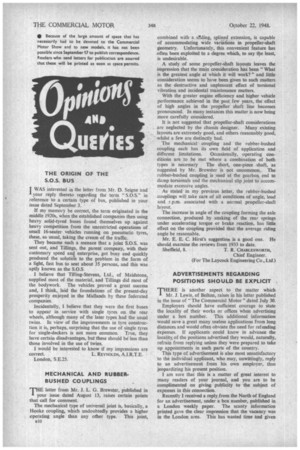THE ORIGIN OF THE S.O.S. BUS
Page 44

If you've noticed an error in this article please click here to report it so we can fix it.
WAS interested ;n the letter from Mr. D. Seigne and -I your reply thereto regarding the term " S.O.S." in reference to a certain type of bus, published in your issue dated September 3.
If my memory be correct, the term originated in the middle 1920s, when the established companies then using heavy solid-tyred buses found themselves up against heavy competition from the unrestricted operations of small I6-seater vehicles running on pneumatic tyres, these, as usual, taking the cream of the traffic.
They became such a menace that a joint S.O.S. was sent out, and Tillings, the parent company, with their customary speed and enterprise, got busy and quickly produced the solution to the problem in the form of a light, fast bus to seat about 35 persons, and this was aptly known as the S.O.S.
I believe that Tilling-Stevens, Ltd., of Maidstone, supplied most of the material, and Tillings did most of the bodywork. The vehicles proved a great success and, I think, laid the foundations of the present-day prosperity enjoyed in the Midlands by these federated companies.
Incidentally, I believe that they were the first buses to appear in service with single tyres on the rear wheels, although many of the later types had the usual twins. In view of the improvements in tyre construction it is, perhaps, surprising that the use of single tyres for single-deckers is not more common. True, they have certain disadvantages, but these should be less than those involved in the use of twins.
I would be interested to know if my impressions are correct. L. REYNOLDS, A.I.R.T.E. London, S E.25.




















































































